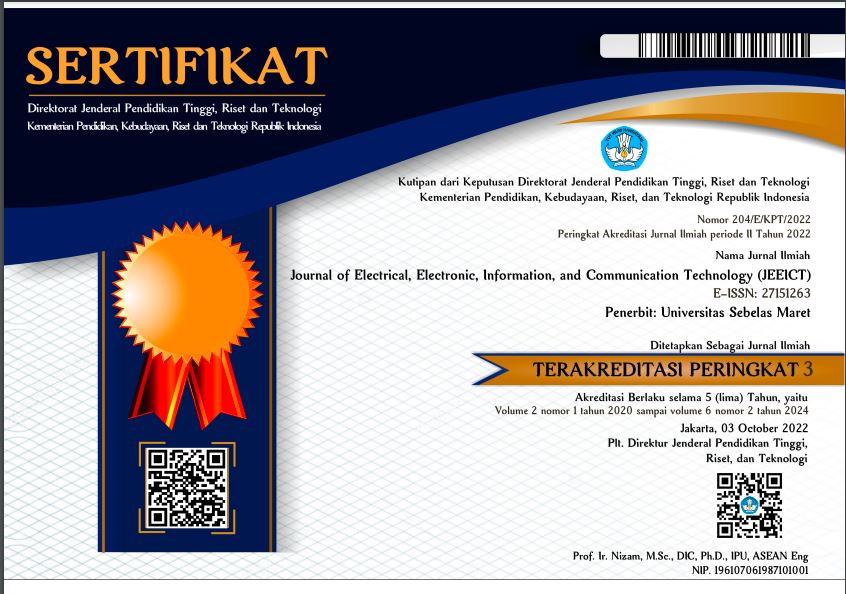Investigation of Cellular Base Transmitter Station Power Radiation using Spectrum Analyzer
Abstract
The development of information and communication technology has spurred the development of the world of telecommunications. The development of telecommunications can be seen from the number of cellular service users supported by technological infrastructure in the form of BTS (Base Transmission Station). But in its development, there are social problems in the form of resistance from the community around BTS, one of the things that people worry about is the danger of radiation from BTS. This could be due to a lack of socialization and knowledge from the community. This study aims to provide education as well as quantitative evidence regarding radiation from BTS in Bulakrejo which is compared with safety standards from International Commission on Non-Ionizing Radiation Protection (ICNIRP) and Ministry of Communication and Information Indonesia. The result of investigation shows that received Power Radiation in near Base Station is safe according to regulatory standard.
Full Text:
PDFReferences
Badan Pusat Statistik Indonesia, “Telecommunication Statistics in Indonesia 2020,” BPS, 06300.2113, Sep. 2021.
Perubahan Atas Peraturan Presiden Nomor 75 Tahun 2014 Tentang Percepatan Penyediaan Infrastruktur Prioritas.
“Dampak ICT terhadap Pertumbuhan Ekonomi di Indonesia,” MASTEL Living Enabler, 01-Dec-2015.
M. Höyhtyä et al., "Spectrum Occupancy Measurements: A Survey and Use of Interference Maps," in IEEE Communications Surveys & Tutorials, vol. 18, no. 4, pp. 2386-2414, Fourthquarter 2016, doi: 10.1109/COMST.2016.2559525.
Wellens, M., Mähönen, P. Lessons Learned from an Extensive Spectrum Occupancy Measurement Campaign and a Stochastic Duty Cycle Model. Mobile Netw Appl 15, 461–474 (2010). https://doi.org/10.1007/s11036-009-0199-9
M. A. Jasim, H. Shakhatreh, N. Siasi, A. H. Sawalmeh, A. Aldalbahi and A. Al-Fuqaha, "A Survey on Spectrum Management for Unmanned Aerial Vehicles (UAVs)," in IEEE Access, vol. 10, pp. 11443-11499, 2022, doi: 10.1109/ACCESS.2021.3138048.
Ian F. Akyildiz, Brandon F. Lo, Ravikumar Balakrishnan, Cooperative spectrum sensing in cognitive radio networks: A survey, Physical Communication, Volume 4, Issue 1, 2011.
"IEEE Standard for Safety Levels with Respect to Human Exposure to Radio Frequency Electromagnetic Fields, 3 kHz to 300 GHz," in IEEE Std C95.1, 1999 Edition , vol., no., pp.1-83, 16 April 1999, doi: 10.1109/IEEESTD.1999.89423.
World Health Organization. (2002). Establishing a dialogue on risks from electromagnetic fields. World Health Organization. https://apps.who.int/iris/handle/10665/42543
M. Hata, “Empirical formula for propagation loss in land mobile radio services,” IEEE Transactions on Vehicular Technology, vol.29, no. 3, pp.317–325, Aug. 1980.
Okumura Y., Ohmori E., T. Kawano, K. Fukuda, "Field strength and its variability in VHF and UHF landmobile service," Review of the Electrical Communication Laboratory, vol. 16, no. 9-10, 1968, pp. 825-873
COST Action 231, “Digital mobile radio towards future generation systems, final report,” tech. rep., European Communities, EUR 18957, 1999.
COST 231, "Urban transmission loss models for mobile radio in the 900- and 1,800 MHz bands (Revision 2)," COST
“Guidelines for Limiting Exposure to Electromagnetic Fields (100 kHz to 300 GHz),” Health Physics, vol.118, no. 5, pp.483–524, May 2020.
K. K. dan I. R. I., Persyaratan Teknik Alat dan/atau Perangkat Telekomunikasi Low power Wide Area.
Refbacks
- There are currently no refbacks.







